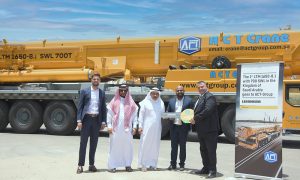Upwardly mobile
Globalisation, competition and cost pressures have driven a decade of change for the mobile crane business.

Globalisation, competition and cost pressures have driven a decade of change for the mobile crane business.
As anyone in the business will tell you, there are two constants in the life of cranes: up and of course down. As they enter 2012, those that sell and market mobile cranes are seemingly glad to report its the latter.
Mobile cranes are defined as machines equipped with a telescopic boom or lattice structure booms and carriers with tyres or crawlers they are used and moved often worldwide. Perhaps the three most common types are all-terrain mobile cranes (AT cranes), rough terrain mobile cranes (RT cranes) and crawler crane. Typically costly to buy, the investment volume for each mobile crane is very high (between $380,000 and $25 million), but they have found their niche in the repertoire of rental companies who are able to reclaim the costs over time.
In many ways, the rental companies have proven to be the saviour of the type. A decade ago the mobile cranes market was facing a crisis. The two strongest markets of North America and Asia, where the leading manufacturers were based, had been in decline for a number of years and the reigning back of capital spending was not only holding back manufacturing but development too. Only in Europe, where players like Liebherr and Demag remained strong, bucked the downward trend.
Fast forward a decade and the mobile crane is undergoing a renaissance. Their adaptability in an era of large scale infrastructure spending, especially in emerging markets such as the Middle East, has made it the flexible friend of sub-contractors working on government and prestige projects.
Last month Construction Machinery ME reported that Sany had won a $2 million deal to sell its mobile cranes to a Saudi Arabian customer and this was followed by the news that one of the UAE’s biggest suppliers Al Faris Equipment took a huge step forward in the segment with its latest order from Liebherr.The Dubai-based company is so confident in the market’s appetite for the machines that it has ordered 47 Liebherr mobile cranes worth more than €40 million from the German manufacturer.
The first units have already been delivered and the order is due to be completed at the end of 2012. Liebherr says another major order is expected early next year for delivery in 2013. The cranes will be a significant addition to the Al Faris fleet which already includes 180 Liebherr cranes.
The order is a varied mixture of telescopic cranes AT cranes and crawler chassis with capacities of between 60 and 750 tonnes. The majority of the cranes are 95 tonne five axle LTM 1095-5.1 and 100 tonne LTM 1100-5.2.
It also includes a considerable number of LTR 1060 and LTR 1100 telescopic crawler cranes. Al Faris opted for these because it says “on long-term construction sites they are considerably more efficient in operation than comparable off-road cranes”.
Liebherr is arguably Europe’s leading manufacturer of mobile cranes and Al Faris will be the latest beneficiary of the company’s decision at the start of the last decade to aggressively pursue business in the sector.
At the beginning of the 1980s Liebherr-Werk Ehingen was the first manufacturer to introduce the all-terrain mobile crane concept as an alternative to the traditional truck crane, and this concept was adopted by the remaining mobile crane manufacturers in the years that followed.
The German company decided in 2000, to concentrate on three main areas to increase its global presence. The first, product development, saw more emphasis on its AT range plus with products such as the MK 80 it opened up the area of the mobile construction crane, machines that combine the advantages of telescopic boom cranes and more conventional construction site cranes.
Secondly it wanted to expand its overseas sales and identified projects such as sports stadia, infrastructure and the energy sector. One of its earliest coups came in Spain where it sold 160 cranes to service the country which was spending heavily at the time ahead of the UEFA football championships and looking to add thousands of wind turbines to the Iberian penninsula – it will be interesting to see if the company and dealer United Rentals can carry on the momentum from working on the Heart of Doha project into the build-up for the similar-looking World Cup in Qatar.
Lastly it learnt from its European business that to succeed worldwide it needed to change the way that mobile cranes were offered to rental companies. Liebherr cranes, like many other German brands, keep their value, and the company realised that it could benefit if it developed a fully functioning pre-owned business.
“The pre-owned crane business is of extreme importance. In many cases the sale of a new crane depends on the existing one being traded in,” GM Friedrich Bär said at the time. “Building up our pre-owned crane sales operation is thus an ongoing activ-ity that enables us to resell the cranes we have taken in part exchange.
“Also of eminent importance is the provision of credit purchase terms for mobile cranes. The higher the value of a pre-owned crane that is offered in part exchange after a period of use, the easier it is to arrange financial terms. High quality, long life and modern technical features ensure that Liebherr cranes have a high resale value on the secondhand market.”
“Also of eminent importance is the provision of credit purchase terms for mobile cranes. The higher the value of a pre-owned crane that is offered in part exchange after a period of use, the easier it is to arrange financial terms. High quality, long life and modern technical features ensure that Liebherr cranes have a high resale value on the secondhand market.”
The bounceback in demand for mobile cranes has had a knock on effect in the sector in some surprising areas. Dunlop, for instance, entered the market in 2010 and the benefits have been almost immediate. According to one of its senior company representatives, sales of Dunlop Goodyear’s ER50 tyre for mobile cranes tyre increased by 173% in 2011. Paul Bould, earthmover tyre specialist for Goodyear Dunlop UK and Ireland said that the ER50, designed by Dunlop in Japan specifically for the mobile crane market has completed a successful launch phase.













